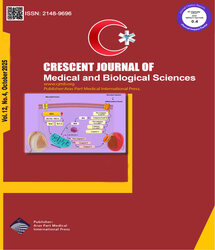Nov 2014, Vol 1, Issue 3



Advanced Search

For Author's & Reviewer's
Poll
How do you find the scientific quality of the published articles on our web site?
| Original Article | |
| Prevalence of Toxoplasma Gondii Antibodies in the Serum of Urban Residents and Ranchers in Tabriz, Iran | |
| Hossein Hashemizadeh Farhang1, Amir Ezatzadeh2, Yones Anzabi1 | |
|
CJMB 2014; 1: 085-089 Viewed : 3864 times Downloaded : 2658 times. Keywords : Antibody, Tabriz, Toxoplasma |
|
| Full Text(PDF) | Related Articles | |
| Abstract | |
Objective: Toxoplasmosis is a common zoonotic infection between man and animal in the congenital
form. This pathogenic agent is transmitted to the fetus through the maternal placenta. This infection is
acquired through the ingestion of oocysts, which are transmitted by cats or through contaminated meat.
Congenital infections can lead to fetal death, pathological changes of the central nervous system (CNS),
or eye diseases. The acquired form of the disease often has no symptoms, or is characterizes by general
lethargy, swollen lymphatic nodes, and chorioretinitis. Fatal and acute infections are observed in the
medically compromised patients or patients with malignancy or tissue plants and AIDS. The purpose of
this study is the investigation of the prevalence of antibody of anti-toxoplasma gondii in the serum of
urban residents and farmers. Materials and Methods: A number of 100 blood samples of urban residents and farmers were collected and tested by the enzyme-linked immunosorbent assay (ELISA) method. Results: Total prevalence of anti-toxoplaxma IgG was 24% in urban residents and 44% in farmers. The prevalence of IgM and IgG positives were higher in farmers than in urban residents. In urban residents, the percentage of IgM and IgG positive was 10%. Conclusion: Due to the high rate of positive cases among the patients, there should be some regular screening programs to recognize chronic infections which may become acute infections. Serial titration measurement should be performed on these patients and they should undergo antiparasitic treatments. |
Cite By, Google Scholar
Submit Paper
Online Submission System CJMB ENDNOTE ® Style
CJMB ENDNOTE ® Style
 Tutorials
Tutorials
 Publication Charge
Medical and Biological Research Center
About Journal
Publication Charge
Medical and Biological Research Center
About Journal
Online Submission System
 CJMB ENDNOTE ® Style
CJMB ENDNOTE ® Style
 Tutorials
Tutorials
 Publication Charge
Medical and Biological Research Center
About Journal
Publication Charge
Medical and Biological Research Center
About Journal
Publication Information
Publisher
Aras Part Medical International Press Editor-in-Chief
Arash Khaki
Deputy Editor
Zafer Akan
Aras Part Medical International Press Editor-in-Chief
Arash Khaki
Deputy Editor
Zafer Akan
Published Article Statistics

















